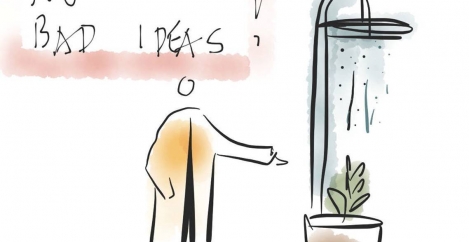October 10, 2018
The Genesis of ideation and the places we go to have our best ideas 0
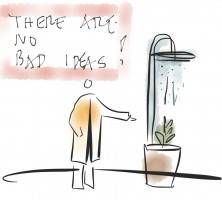 Because collaboration, creativity and innovation are increasingly perceived as key objectives and differentiators of performance, the genesis and mechanisms behind ideation and creativity are an an integral part of both business and personal development. As a consequence, there is growing interest in the way the physical attributes of work settings may influence or even trigger creative behaviour. The cliché of the shower as one of these favourite places comes to mind and yet experience does show that the idea of seeking a setting, a “zone” if you will, for a specific purpose is intuitively right. This needn’t be a retreat or cocoon, as is often assumed, but can also be a crowded, busy, noisy place, which might explain why so often the most animated work conversations move out of the office shop into the coffee shop. Equally, highlight events or special meetings tend to be held in a “venue’, often dressed for the occasion.
Because collaboration, creativity and innovation are increasingly perceived as key objectives and differentiators of performance, the genesis and mechanisms behind ideation and creativity are an an integral part of both business and personal development. As a consequence, there is growing interest in the way the physical attributes of work settings may influence or even trigger creative behaviour. The cliché of the shower as one of these favourite places comes to mind and yet experience does show that the idea of seeking a setting, a “zone” if you will, for a specific purpose is intuitively right. This needn’t be a retreat or cocoon, as is often assumed, but can also be a crowded, busy, noisy place, which might explain why so often the most animated work conversations move out of the office shop into the coffee shop. Equally, highlight events or special meetings tend to be held in a “venue’, often dressed for the occasion.
So too with the very special activity that is the generation of ideas or ideation. Not to be confused with innovation. Not all ideas are or need to be innovative but all are defined as ideas in that they are, with varying degrees of success, the expression of creative thinking and problem solving.
From the start, I would like to dispel two myths. The first relates the use of the term “creativity” in the context of business. Business has embraced some of the language and, in the face of the failure of traditional management systems, sought to appropriate the language, techniques and structure that are typical of the Arts; is this legitimate and to what purpose? Perhaps it is therefore more fitting to be discussing ideation in the context of knowledge exchange and creation.
In 1995 Nonaka and Takeuchi introduced the SECI model, which has become the cornerstone of knowledge creation and transfer theory. They proposed four ways that knowledge types can be combined and converted, showing how knowledge is shared and created. The model is based on the two types of knowledge:
- Explicit
- Tacit
Most knowledge is tacit
A major challenge that businesses, aiming to break a mechanical, systemic and stale pattern of behaviour at work, encounter is in transforming their tacit knowledge into explicit knowledge. This is what we may otherwise call ideation and which requires the kind of spaces and associated culture that encourage a free flowing exchange of ideas and acclimatise people to the habits of sharing and learning.
The second myth I would like to dispel is that of the single introspective creative act suggesting in its place that ideation, as knowledge exchange, is a collaborative orchestration of inputs. In that creation is the response to external inputs from any given context, it is, by definition, collaborative as no idea emerges from a void but is the result of interaction. The more diverse and large the creative team, the richer the creative process.
Articulating ideation into distinctly structured stages is not contrary to the creative act. A creative process does indeed possess structure. While it may wander, it is a hugely purposeful and intense mission. That intensity of thought and reasoning needs to be maintained alive throughout the process. When doing so, it is best to let development of ideas take place in bursts, broken up by periods of pause, reflection and discussion. The idea of continual refinement is in fact implicit in the notion of ideation. It is achieved through a timely sequence of successive layering, which enriches and confers depth to the ideas being developed. The more often ideas are tabled and discussed, exposed, shared, stripped apart and compared with others, the better the outcome.
Believe it or not, these are what we call meetings and, when they are loaded with the ambition to generate ideas they become brainstorming meetings, the official sanctum of ideation. With productivity, personal fulfilment as well as target setting in mind, the true purpose of meetings is never clearly stated but often includes ideation, resolution and crisis management.
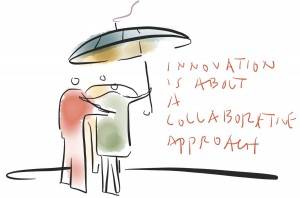 David Pearl, founder of the Meeting Doctor initiative and author of “Will there be Donuts”, states that there is no such thing as ‘just a meeting’; meetings are particular and can be defined by their specific intention and their function.
David Pearl, founder of the Meeting Doctor initiative and author of “Will there be Donuts”, states that there is no such thing as ‘just a meeting’; meetings are particular and can be defined by their specific intention and their function.
Here are just a few key examples:
Dialogue
- Definition – free exchange of ideas between two or more participants.
- Conditions – informal, eye-to-eye, no obstacles, comfort, human, lively.
Discuss
- Definition – two or more people purposefully hammering out an idea or issue.
- Conditions – high connectivity, good sightlines for whole group, focus, energy.
Debate
- Definition – a form of confrontation between those proposing and opposing an idea in order to find an answer.
- Conditions – formal, two sides of the table, bi-cameral, high energy, a creative confrontation.
Decide
- Definition – a meeting to bring a conversation to a close with definitive action.
- Conditions – formal, efficient, no distraction.
Devise
- Definition – creative meeting to invent new ideas or approaches.
- Conditions – open ended, playful, and organic, props to facilitate creativity.
Direct
- Definition – operational meeting to direct the business, distribute information, delegate tasks.
- Conditions – focus on meeting host, purposeful assemble, briefing, absorbing information easily.
Increasingly ideation is seen as trigger and spark of business growth…but are we ever really creatively meeting?
Ubiquitous communication technology has eliminated the constraints of time and location with regards to ability and opportunity for interaction and knowledge exchange, yet this freedom has also diluted the significance of individual meeting moments and removed a natural sense of hierarchy, place, priority or joy in the enacting of the meeting. Moreover, the primary reason for meeting is often forgotten with company procedures, format, timetabling as well as pre-conceptions and expectations about what the nature, duration and objectives of the meeting should be, thus taking over and distracting from their true intent. Crucially, the attributes of the environment are rarely acknowledged to be playing any part in shaping and supporting ideation. Knowledge exchange and communication tend to inhabit the spaces provided as part of general office infrastructure rather than being the spaces that might inspire best results.
“Today the trend is towards de-institutionalization, hybrid forms of organisation and co-operative mastery of knowing and knowledge production, towards open expertise produced in multi-actor networks.”
…. Supervision in Social Work – S. Karvinen-Niinikoski, 2004
Creative encounters are about achieving the potential of assembled participants.
Like a theatrical or musical performance it is a moment in time – a gig – the success of which depends on timing and effect. Involving all in an organisation is important, but, contrary to common belief, this need not be at all times all of the time. Role-playing is key to allocation of parts in well-managed interaction. Benefits of successful interaction are derived from the achievement of quantifiable outcomes but also and in a large part from the enjoyment of being part of the experience and the knowledge network.
 Knowledge workers with large social networks tend to perform better than those with small personal networks through better access to information and an attitude that ‘can get things done’. However, knowledge workers who span boundaries tend to perform better through access to different information, thus, new information, which may generate new ideas and an attitude that can spin information beyond the obvious and convectional – hence, the genesis of an idea.
Knowledge workers with large social networks tend to perform better than those with small personal networks through better access to information and an attitude that ‘can get things done’. However, knowledge workers who span boundaries tend to perform better through access to different information, thus, new information, which may generate new ideas and an attitude that can spin information beyond the obvious and convectional – hence, the genesis of an idea.
So, ideation has to do with networks of knowledge workers meeting effectively.
“Face-to-face interactions are by far the most important activity in an office; creating chance encounters between knowledge workers, both inside and outside the organization, improves performance.”
…Workspaces that move people, HBR – B. Waber, J. Magnolfi, and G.Lindsay, 2014
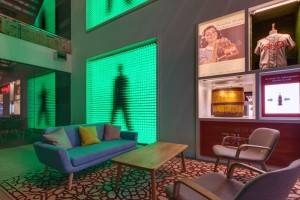 When it comes to the attributes of the physical environment the current trend and misconception is to associate creative work with settings that have been creatively shaped and are quirky, funky, fun and such other. When Coca-Cola appointed MoreySmith in 2011 to design the interiors for their new European Headquarters in London (picture, their brief was to enhance the creative work by creating a wide array of stimulating settings. They wanted an interior that was authentic, lived in, not too finished or polished, allowing for individual input and personalities.
When it comes to the attributes of the physical environment the current trend and misconception is to associate creative work with settings that have been creatively shaped and are quirky, funky, fun and such other. When Coca-Cola appointed MoreySmith in 2011 to design the interiors for their new European Headquarters in London (picture, their brief was to enhance the creative work by creating a wide array of stimulating settings. They wanted an interior that was authentic, lived in, not too finished or polished, allowing for individual input and personalities.
While the result was artistically and technically flawless, this is a case of mistaking the quality of the environment with that of the activity.
“The house of happiness is not just our house, it will drive the reputation of Coca-Cola as a unique workplace”
…James Quincey – President and COO, Coca-Cola
Google, whose offices have long been associated with the company’s colourful and vibrant branding, currently 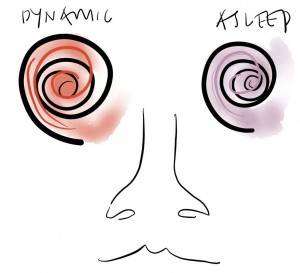 promotes another take. Partnering with The Center for the Built Environment (CBE) at Berkeley University of California, Google are carrying out ground breaking research on healthy workplaces that positively impact the health and well-being of their employees by approaching buildings as living systems, designing for daylight, clean air, and removal of harmful toxins and chemicals.
promotes another take. Partnering with The Center for the Built Environment (CBE) at Berkeley University of California, Google are carrying out ground breaking research on healthy workplaces that positively impact the health and well-being of their employees by approaching buildings as living systems, designing for daylight, clean air, and removal of harmful toxins and chemicals.
Health and wellbeing expressed as environmental quality are often some of the main factors affecting ideation at work. Work environments are still for the most perceived as a matter of furniture and finishes selection. However, as the CBE research is showing, there are however imperceptible factors, which dramatically improve comfort at work, including Air and Light quality. Key recommendations under the two headings included the following:
Air
- Improve the quality and quantity of natural ventilation,
- Allow individual access to operable windows
- Separate ventilation air from thermal conditioning,
- Provide task air for individual control.
Light
- Maximize the use of day lighting without glare,
- Separate task and ambient light,
- Select the highest quality lighting fixtures,
- Design plug-and-play lighting and dynamic lighting zones.
The premise of this kind of research is that neutral but healthy backdrops to creative activity can foster a state of wellbeing and alertness that is a necessary predisposition to ideation.
“People work best when all senses are engaged”
… Sense Sensitive Design – IBI Group/Think, 2012
In the context of clinical environments, Aaron Antonovski has argued that health treatments could be strengthened and enhanced through environments that are salutogenic – i.e., that focus on the factors that keep us well. The aim of salutogenic design is to stimulate the mind in order to create pleasure, creativity, satisfaction and enjoyment. There is an important relationship between an individual’s sense of coherence and the characteristics of the physical environment.
Back to the future (of the office)
Powerful economic, social and technological triggers for reinventing workplace have emerged. However, office typologies remain constrained by a codified approach to space that takes the form of a reliable yet predictable set of spatial and organisational typologies. It’s (increasingly) about people and about giving them opportunity to express an idea. Organizations are beginning to see the value in giving their talented employees a voice and spaces for it to be heard.
“Business performance is influenced by the impact of the workplace environment on staff motivation and ability”
… The Impact of Office Design on Business Performance – CABE, 2005
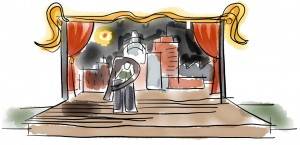 In conclusion, the workplace of the future could act as an ideation environment that supports and facilitates an event orchestrated and choreographed to yield the desired business outcome. Such an environment recognizes the distinct moments of the creative thinking as they unfold and offers effective timely props for full effect. It constitutes the perfect alignment of workspace and business strategy on an experiential level as articulated under the following four headings
In conclusion, the workplace of the future could act as an ideation environment that supports and facilitates an event orchestrated and choreographed to yield the desired business outcome. Such an environment recognizes the distinct moments of the creative thinking as they unfold and offers effective timely props for full effect. It constitutes the perfect alignment of workspace and business strategy on an experiential level as articulated under the following four headings
Understanding of the importance of ideation in business and its links to productivity, through:
- Acting – enact business as theatre, leading to multiple possible outcomes
- Improvising – accepting unexpected results depending on inputs, timing and dynamic of the ideation journey
- Jamming – harmonising the different workplace actors
- Sensing – understanding needs, communicating solutions and responding to feedback
Defining possible metrics for identifying success criteria of business innovation, through:
- Collating qualitative data
- Playing out realities (gaming)
- Quantifying qualitative measures of success
- Technology – user responsive and user centric
Highlighting the direct/indirect relationships between physical space and business activity, through:
- Sense Sensitive Design – understanding the impact of the environment on physical and emotional wellbeing and motivation
- Nutrition – increasing energy levels, giving pleasure and reducing allergies
- Stimulus – using sensory experience to awaken senses, engender a response
- Familiarity – reassuring features and routines associated with the workplace
Appreciating the impact of space on creative behaviour in the workplace, through:
- Psychogeography – an approach to geography that emphasizes playfulness and drifting (dérive) around urban environments. It’s about how we’re affected by being in certain places – the architecture, the weather, whom you’re with – a general sense of excitement about a place.
- Empathy – collaboration for individual and team success / staying connected to team needs
- Flexibility – adaptability to changing work styles and business needs / iterative and experimental mind set
- Empowerment – ownership and sense of initiative / suggestive rather then prescriptive / encouraging an environment that promotes curiosity
This article features in Work&Place
__________________________________
 Giuseppe Boscherini is a qualified architect (Dip Arch UCL/RIBA), industrial (MDes RCA) and interior designer, with 30 years’ experience leading and inspiring design teams within internationally renowned practices such as Foster and Partners, Gensler, IBI, Woods Bagot and CBRE, on multidisciplinary projects for global clients.Most recently, he was Creative Director at CBRE Workplace Consulting group, facilitating client workshops, enhancing project content and leading research initiatives. He now runs his own London-based studio.
Giuseppe Boscherini is a qualified architect (Dip Arch UCL/RIBA), industrial (MDes RCA) and interior designer, with 30 years’ experience leading and inspiring design teams within internationally renowned practices such as Foster and Partners, Gensler, IBI, Woods Bagot and CBRE, on multidisciplinary projects for global clients.Most recently, he was Creative Director at CBRE Workplace Consulting group, facilitating client workshops, enhancing project content and leading research initiatives. He now runs his own London-based studio.
email giuseppe@boscherini.com





